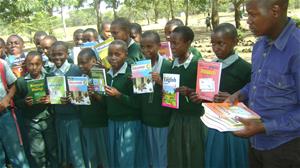 Sometimes several small investments can have an even greater overall impact than
a single big investment.
Sometimes several small investments can have an even greater overall impact than
a single big investment.
That’s just one of the lessons learned in Tanzania last year when the Kilimanjaro Literacy Association (KLA) invested five International Literacy Association (ILA) mini-grants into projects that eventually affected more than 1,100 people—including teachers, students, families, and entire villages.
According to Meyasi Mollel, KLA’s president and cofounder, the ideas for the projects grew out of a literacy ambassador training workshop held by ILA, which included project brainstorming and grant writing training. The next step was to submit applications for ILA’s grant program, Grants for Literacy Projects in Countries With Developing Economies.
As a result, they were approved to receive funding for five projects:
1. The Tanzania Entrepreneurial Literacy Lesson Project, which improved communication
literacy, financial literacy, and informational literacy within the framework of entrepreneurial
skills development. Community members learned recordkeeping, cash sales/flow, marketing, and
communication skills. They also founded a microloan financing organization to fund their own
business ideas.
2. The Practical Literacy for Adolescents Project, which focused on literacy activities
related to adolescent health, reproduction, and social behavior, and included minilessons,
discussions, dramatization, group work, and ample feedback.
3. The Environmental Conservation Literacy Program, which focused on the critical role of literacy in solving environmental problems. Primary and secondary student activities included reforestation education, cleanups, essay writing, and provision of supplementary literacy resources.
4. The Primary School Libraries in Tanzania Project, which supported the creation of three
libraries and trained personnel. Parents provided one book each and additional books were purchased through grant funding.
5. The Rural Reading Project, which helped build reading habits in the Nadosoito village
by conducting house-to-house lessons in basic book access modeling, read-aloud/think-aloud, discussions, and reflections. Materials were also provided to the village in order to sustain a culture of reading post project.
Mollel says the entrepreneurship program likely had the biggest impact. Some 128 Maasai people from the village of Naiti, located in the Monduli area of Tanzania, developed their own business skills selling milk and established a community market. They leveraged milk sales to fund a microloan program, which in turn enabled 120 people to develop their own businesses selling clothing, vegetables, beads, and other products.
Amy Schulte, manager of ILA’s Global Operations Unit, says the ILA Grants for Literacy Projects in Countries With Developing Economies were made possible by voluntary contributions from ILA members and partners. The program offers one-time grants to ILA members who seek support for a literacy project in their own countries. The number of
grants, which total up to $2,500 each, are determined by the amount of donations made to the fund annually.
This was the first time multiple grants were awarded to a single area, says Schulte, who notes that the span of projects goes to the heart of why ILA changed its name from the International
Reading Association.
“It’s not just about reading,” she stresses. “It’s about literacy in the broader aspect, especially in the developing country context. If your only way of making ends meet is to sell the milk from your cow and you can’t write out a bill of sale, then you are unable to do that. Literacy is also the ability to understand, interact with, and shape your world to be successful. That’s what we thought was a really unique part of KLA’s projects—that they took the expanded view of literacy and impacted all these different contexts, focusing on the specific needs of this particular
population.”
By providing what amounts to a small “saturation grant” for a single location, ILA allowed KLA to plant more seeds of information, skills, and life strategies for a broader segment of the local community.
Notes Mollel: “We are still in touch with communities that participated in the grants, and we will be looking for more grants.”
As for what other ILA affiliates can learn, Mollel advises that literacy efforts should go beyond school walls.
“By focusing on authentic and specific community subsegments and needs, the grants went far beyond providing books or training villagers on how to access business information and strategies,” Mollel says. “It actually increased future potential for people to gain the information and skills they will need to continue to compete in a life that is rapidly changing [and] providing
increased opportunity for those who have basic skills.”
Impact: By the numbers
Here are a few statistics that reflect the wide-ranging impact of the five KLA projects on students, parents, and the wider community:
- 128 Naiti villagers received entrepreneurial literacy training and created their own market to sell their products.
- 500 trees were planted at five schools.
- 250 students received conservation literacy training.
- 560 books were purchased.
- The ratio of books to students dropped from 1:8 to 1:2.
- 70 families in Nadosoito received house-to-house reading lessons.
- 646 students were involved in literacy projects.
- 48 teachers were trained to become literacy ambassadors.
See the ILA Grants for Literacy Projects in Countries With Developing Economies or e-mail ILA for information on the program and how to donate.
Maura C. Ciccarelli is a freelance writer specializing in education and nonprofits, as well as a wide variety of other topics.
This article originally appeared in the January/February 2016 issue of Literacy Today, ILA’s member magazine.